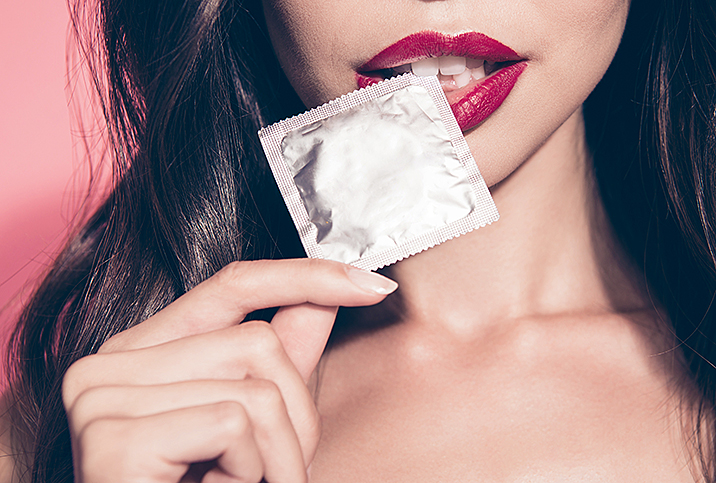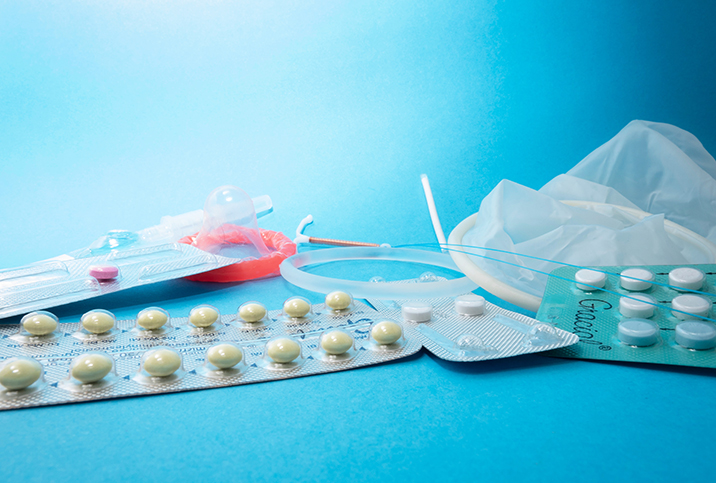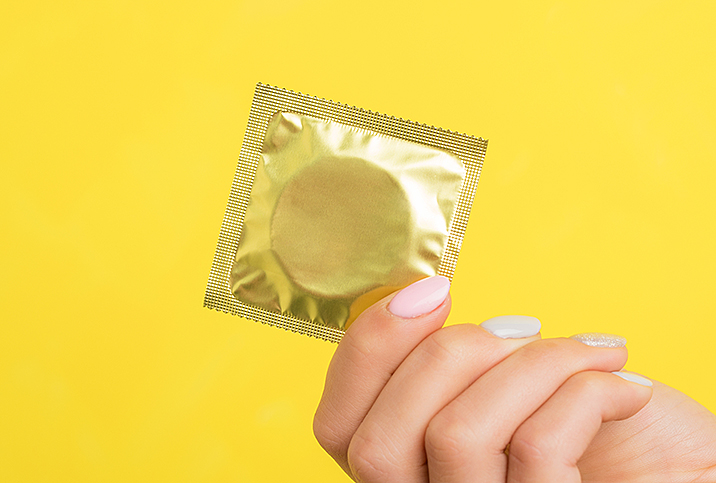Do You Know What's In Your Condoms?

Condoms are an accessible, popular and effective contraceptive that provide protection from sexually transmitted infections (STIs) and unwanted pregnancy. Ironically, some of the ingredients in condoms may actually increase the risk of getting STIs, yeast infections and other conditions by causing irritation or allergic reactions, or disrupting the vaginal microbiome.
When people have an allergic reaction to condoms, they often assume they have a latex allergy. However, only around 4 percent of the general population has a latex allergy, so it's more likely people are allergic to one of the many ingredients used to make condoms smooth, moisturized and more effective.
The U.S. Food and Drug Administration (FDA) classifies latex condoms as Class II medical devices, which means manufacturers are not required to list the ingredients. We'll discuss the common ingredients found in condoms that can cause issues for some people, as well as alternatives you can try.
8 ingredients in condoms to bear in mind
First things first: There are no inherently "bad" or "good" ingredients in condoms.
"What's most important is to note if you are having topical reactions to any of these substances," said Rahima Alani, M.D., a family physician and medical advisor for Reya Health, a digital platform based in Toronto that helps women find personalized birth control options.
Consider whether your condoms contain any of the following ingredients:
1. Powders
Powders are used in non-lubricated condoms to prevent the condom from sticking to itself or tearing. In the past, this was often talcum powder, but talc is no longer commonly used because of its link to ovarian cancer.
Many condom producers now use cornstarch instead, which is made from corn kernels. However, the cornstarch can also be mixed with preservatives, such as silica or antioxidants, to make the condom last longer. These are not inherently harmful but could cause an allergic reaction in some people.
2. Lubricants
"Any lubricated condoms that don't state otherwise will have glycerin," Alani said.
While not harmful itself, glycerin can damage or irritate cells, which potentially increases the risk of getting STIs, such as herpes and HIV.
"When left in the vagina, [glycerin] can transform into sugar, which can disrupt the vaginal pH balance and cause yeast infections," said Raja Agnani, M.B.A., co-founder of P.S. Condoms, a vegan condom brand.
"If you haven't had issues with glycerin-based lube, then the amount in condoms is not an issue. However, many people do experience a change in the acidity of the vagina with glycerin-based lubricants, so they prefer water-based," Alani added.
Condoms with silicone lube can be another safe option because silicone doesn't get absorbed by the skin and doesn't leach chemicals into your body.
Bottom line: Read the condom ingredients carefully so you know which lubricant is used. If you develop a reaction, you'll know which type to avoid in the future.
3. Spermicides
Some condoms contain spermicide, which immobilizes sperm, preventing it from reaching the egg. The spermicide most often used is nonoxynol-9 (N-9), a petroleum-based chemical.
However, data suggests the slight amount of spermicide on condoms isn't enough to make spermicide-coated condoms any more effective at preventing pregnancy than non-coated condoms, which are 98 percent effective when used correctly. If you want to use spermicide, a better option would be to purchase it separately and use it as directed along with condoms, which can increase the efficacy to 99 percent.
However, it's important to note that N-9 does not prevent sexually transmitted diseases or infections, and actually kills cells inside the genitals and rectal walls, which can increase the risk of STDs/STIs. Spermicide can also cause vaginal burning and irritation, and increase the risk of urinary tract infections (UTIs).
4. Numbing agents
Numbing agents are marketed to men who experience premature ejaculation and claim to help them perform better.
"Benzocaine is a local anesthetic used in some condoms which promise to make men last longer in bed by reducing sensitivity where it counts," Agnani said.
While a small amount of benzocaine may be harmless, using a large amount and using it too often can cause severe toxicity or an allergic reaction. Use caution when buying condoms that offer "extended pleasure" or claim to help you "last longer."
5. Flavorings
Vanilla, bubblegum and other flavored condoms can make oral sex more interesting, but their use should end at foreplay. Flavorings are made with sugar (glucose), which can cause yeast infections, just like lubes with glycerin. It's always best to keep scented and flavored products out of your vagina.
6. Nitrosamines
Nitrosamines, a byproduct of latex production, are another ingredient to be aware of in condoms. N-nitrosamines, as they're formally known, are potent carcinogens, and it was previously speculated that their use in condoms could lead to cervical cancer.
However, studies have since suggested the risk of cancer from nitrosamines in condoms is "very low," according to a 2001 review in the International Journal of Hygiene and Environmental Health. Researchers also noted that "humans are regularly exposed to nitrosamines from food and tobacco smoke at a dose which is 1,000- to 10,000-fold higher than expected from condom use."
"Some flavored condoms may have nitrosamines just from the flavor, and the amounts within the transfer are essentially unknown," Alani said. "If you feel it's a risk that's not worth it, non-flavored and non-latex condoms should be nitrosamine-free."
7. Parabens
Parabens are a commonly used preservative found in many items, including processed food, cosmetics, pharmaceuticals and condoms. Parabens prevent bacteria buildup while the condom is inside the package.
The human health effects from parabens at low doses are unknown, but parabens do not accumulate in the skin or other body organs, according to the Centers for Disease Control and Prevention (CDC).
Scientists have discovered that parabens may disrupt estrogen by mimicking the hormone, and have found paraben compounds in breast tumors, according to a 2017 study in the International Journal of Molecular Sciences. However, the amount of parabens used in products, including condoms and cosmetics, is low, and the specific type of parabens used for these products is metabolized quickly by the body. Due to this rapid metabolization, researchers believe only daily and extensive use of products containing parabens would eventually lead to accumulation.
Based on current research, parabens are classified as non-teratogenic, non-mutagenic and noncarcinogenic, and are considered safe for use, according to a 2021 review in the medical journal Acta Pharmaceutica.
8. Casein
Casein is a milk protein that makes latex condoms smooth, thin and flexible.
"Casein can irritate some people who are sensitive to dairy products. It's also what gives condoms that awful rubbery smell," Agnani said.
It's best to look for vegan condoms if you want to avoid this ingredient.
How to find the best condoms for your body
Finding condoms with better ingredients isn't a cakewalk, but you can do it with a bit of research.
"Consumers can keep their bodies safe by paying attention to the ingredients used by the condom brand and ensuring that they don't include any of the items listed above," Agnani suggested.
You can first go to the condom company's website and try to find the ingredients there. If there's not much information on the website, email the company or call them and ask for ingredients. The best way to create change is to demand transparency. Many condom companies focused on alternative options differentiate themselves by being transparent about their ingredients.
"Today's customers are looking for products with better, cleaner ingredients and brands that are more inclusive," Agnani said.
Condoms made with natural rubber latex, cornstarch powder and silicone lube are a good place to start.


















